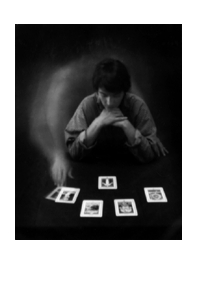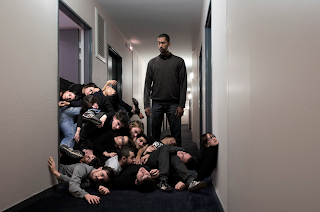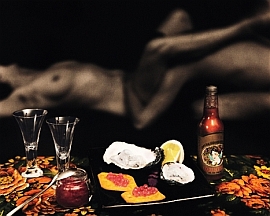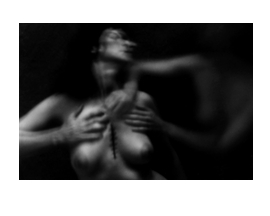Paul Schnegenburger's The Sleep of the Beloved series is hauntingly disturbing, yet somehow familiar. He set up his camera in candlelight for 6-hour exposures in his studio, photographing how couples sleep together. Some moved all night, others stayed still for hours on end. Some cuddled in their sleep, others stayed away from each other. It's all an intricate dance every couple performs every night. There is a loss of control when we sleep. It's interesting to think it may be a reflection of how they interact during waking hours.
There is a certain beauty in the motion and tonal range of these images. Some faces are obscured, others are so clear you may recognize on the street. This is such an interesting concept. Long exposure / time-lapse photography is a technique I have considered trying in the future. This series has opened my eyes to explore it in more ways than I previously considered. Time to start planning...
View more of his images at: www.schneggenburger.at/
Thursday, February 21, 2013
2- Amanda Schweizer submits Romain Laurent
Romain Laurent's images evoke both humor and intrigue. I found myself chuckling at his images, but was then left scratching my head wondering how he accomplished the illusions in his images.
Laurent's Tilt series depicts street scenes in which the character is upright and the street is off-kilter... or is the other way around? Interpretation is left to the viewer. The shadows match the rest of the scene, yet you see no support wires or posts to explain this trick of the eye. They are most intriguing.
His TAS series cracks me up in that there are piles of objects, even people, spilling out of doorways into the path of an "innocent bystander" who seems puzzled, but not alarmed, by what he/she sees. There seems to be a theme of how cluttered our lives are and how things just seem to pile up until an avalanche cuts loose. His avalanches include people, record albums, shoes, and even fish. In the office hallway image, I really appreciate how the avalanche spills out, then starts to creep up the opposite wall. It reminds me of a real avalanche site I visited in the Colorado Rockies where a similar phenomenon occurred as trees were leveled as the avalanche flowed down the mountain, across the road, and up the face of the mountain on the other side of the road. It was very surreal.
Laurent's L'Horizon series reminds me of my surfer cousin from Corpus Christi who now lives in New York City and always seems a bit lost in the sea of people. The surfer in the images is completely out of place, searching the horizon for the next big break. It's dreamlike in that he is floating above the sidewalks and streets, oblivious to what is going on around him. Yup, that's Josh alright!
As I stated before, I really appreciate the humor and intrigue Laurent captures in his images, as well as the amount of time and effort that goes into each shooting session. Bravo for making us study the images to figure out how they were accomplished and keeping us chuckling at the same time.
View more of his images at: www.romain-laurent.com/
Laurent's Tilt series depicts street scenes in which the character is upright and the street is off-kilter... or is the other way around? Interpretation is left to the viewer. The shadows match the rest of the scene, yet you see no support wires or posts to explain this trick of the eye. They are most intriguing.
His TAS series cracks me up in that there are piles of objects, even people, spilling out of doorways into the path of an "innocent bystander" who seems puzzled, but not alarmed, by what he/she sees. There seems to be a theme of how cluttered our lives are and how things just seem to pile up until an avalanche cuts loose. His avalanches include people, record albums, shoes, and even fish. In the office hallway image, I really appreciate how the avalanche spills out, then starts to creep up the opposite wall. It reminds me of a real avalanche site I visited in the Colorado Rockies where a similar phenomenon occurred as trees were leveled as the avalanche flowed down the mountain, across the road, and up the face of the mountain on the other side of the road. It was very surreal.
Laurent's L'Horizon series reminds me of my surfer cousin from Corpus Christi who now lives in New York City and always seems a bit lost in the sea of people. The surfer in the images is completely out of place, searching the horizon for the next big break. It's dreamlike in that he is floating above the sidewalks and streets, oblivious to what is going on around him. Yup, that's Josh alright!
As I stated before, I really appreciate the humor and intrigue Laurent captures in his images, as well as the amount of time and effort that goes into each shooting session. Bravo for making us study the images to figure out how they were accomplished and keeping us chuckling at the same time.
View more of his images at: www.romain-laurent.com/
Monday, February 11, 2013
Sheridan O'Neal submits Edward Burtynsky
His series “Exploring the Residual Landscape” focuses on how industry affects nature. He photographs recycling yards, mine tailings, quarries and refineries in order to emphasize his ideas yet keep the meanings of the work open to the viewer. He attempts to convey that the world suffers at the expense of human success and portrays the interaction between man and environment. He also helps to advertise other companies who are trying to clean the environment such as WorldChanging and Basel Action Network. His photographs of the junk yards, tire piles, and recyclable materials convey his meaning of showing the massive wastefulness of the human race. However, some of his other works such as his images of homesteads and quarries lose their meaning. I like how in the oil filters and tire piles the mass repetition of the objects that have been used and are now waste accurately convey the need to clean up the environment while still being drawn to the beauty of the image itself. I like how the repetition of the tire image creates another texture and environment. I also like how the tires are so clear in the foreground and they slowly fade to the mass of tires in the background. http://www.edwardburtynsky.com/index.html
Sheridan O'Neal submits Martha Casanave
Casanave graduated from the Monterey Institute of International Studies with a degree in Russian Language and Literature and began her working life as a translator in Washington, DC. She began to focus on portraiture and began to teach photography while building on her personal work in Monterey. I mainly looked at two of her series. Kitchen Kama Sutra is based off of the the love teachings of the kama sutra. It displays shameless black and white sex scenes in the background and the foreground is composed of a colorful food still life. She represented the shamelessness of sex by comparing and contrasting it with the food in regards to appetite and nourishment. I think the compositions of her subjects interest me the most in her use of muted tones in the back and the juxtaposition of the bright colors in the foreground. Also, the play between movement and still life. However, before reading her notes on the series I interpreted the images as ironic in that the distasteful scenes in the background be further pushed there by the elegance and precise beauty of the foreground. It reminded me of the sculptor Ann Wood who decorates taxidermy in order to comment on the public’s enjoyment of violence and sick sense of entertainment by covering these animals in bright colored frosting and flowers with pools of blood coming out. http://marthacasanave.com/kama.htm
 I also really enjoyed her pinhole narratives which she created using a 4x5 camera and addressing women’s experience and memories in our society. I love how she blurs the figures and imagery while keeping some clarity. It gives the photos a ghost like quality to represent an idea , the past, motion, or repetition. The anguish in the second photo and the movement created in the blurring creates a dynamic composition and subject matter.
I also really enjoyed her pinhole narratives which she created using a 4x5 camera and addressing women’s experience and memories in our society. I love how she blurs the figures and imagery while keeping some clarity. It gives the photos a ghost like quality to represent an idea , the past, motion, or repetition. The anguish in the second photo and the movement created in the blurring creates a dynamic composition and subject matter.
Subscribe to:
Posts (Atom)









.jpg)




